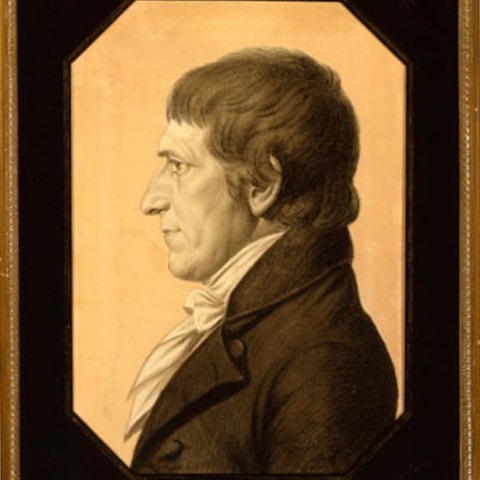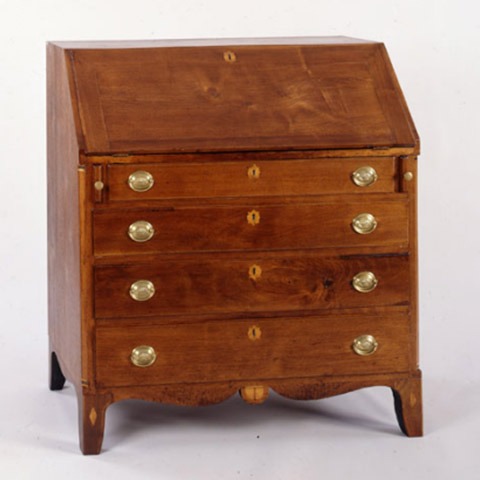American Federal Period
Between 1775 and 1787, the new United States of America went through an unprecedented period of military and political turmoil, between the Revolutionary War beginning in 1775, the signing of the Declaration of Independence the next year, and the ratification of the Constitution in 1787. Delaware was the first state to sign the Constitution that year, and the effects of war and beginning a new nation could be seen through the artwork produced during the period. The fine and decorative arts of the emerging First State reflected the more sobering cultural tone of Federal America. The influential design book by British architects Robert and James Adam, Works in Architecture (1773), popularized a decorative arts aesthetic influenced by classical archaeology. This complemented the new American political system based on the democracy of classical Rome and Greece. Portraiture of this period emphasized flattering likenesses, anatomical accuracy and formal poses.
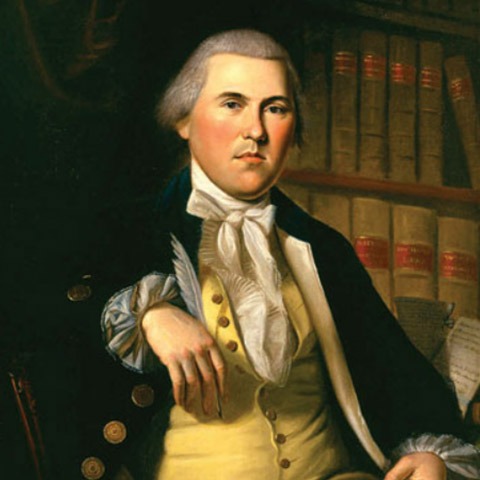

Charles Willson Peale, one of America’s first famous portrait painters, studied with Benjamin West (1738–1820) in London for two years. It was during this time that the European neoclassical interest in realism—a precise and almost scientific depiction of the natural world—seems to have influenced him. While a prolific painter in Philadelphia, the artist also fathered seventeen children, many of whom he trained, along with several nieces and nephews, to be professional artists.
MASKELL EWING
CHARLES WILLSON PEALE (1741–1827)
1787
OIL ON CANVAS
SEWELL C. BIGGS BEQUEST; 2004.438


Gilbert Stuart idealized his subjects with a romantic approach to painting, finely blending flattering colors to emphasize the sitter’s personality through facial expression and pose. Considered one of the best portrait painters of the American federal period, Stuart painted many of America’s most influential people.
ELIZABETH LAWRENCE (MRS. WILLIAM) LECOMPTE
GILBERT STUART (1755–1828)
CA. 1800–10
OIL ON PANEL
SEWELL C. BIGGS BEQUEST; 2004.423


This armchair, along with two accompanying side chairs also in the Biggs Museum’s collection, exhibits many of the new decorative techniques favored by consumers of the Federal period. Instead of the curvaceous designs of Baroque- and Rococo-period furniture, Federal furniture is rectilinear and slim with fine tapered components. Federal-period cabinetmakers often relied on shallow relief carvings and inlayed details to decorate their delicate furniture forms.
ARMCHAIR
MAKER UNKNOWN
PHILADELPHIA, PENNSYLVANIA, 1800-15
MAHOGANY, MAHOGANY VENEER, ASH
GIFT OF SEWELL C. BIGGS; 1992.101


Daniel McDowell (working ca. 1793-1830), the maker of this sideboard, and his brother, James (1785–1836), probably apprenticed under John Janvier (1777–1850), who was an influential artisan of Odessa, Delaware. While James settled in Smyrna, Delaware, Daniel made fashionable furniture in Dover, the new state capital.
SIDEBOARD
DANIEL MCDOWELL (WORKING CA. 1793–1830)
DOVER, DELAWARE, 1810
MAHOGANY, MAHOGANY VENEER, TULIP POPLAR,
WHITE PINE
SEWELL C. BIGGS BEQUEST; 2004.172


According to family tradition, this silver service commemorates the wedding of Amelia Theresa Stone to Evan Morris, which took place in 1807 in Wilmington, Delaware. However, the service bears the marks of two different silversmiths, and one of those marks appears in two different versions, suggesting that portions of the set were perhaps made years after the 1807 wedding. However long it took to accumulate this impressive service, the silversmiths matched the pieces with the same neoclassical decorations. These include an urn silhouette, urn finial, applied beading, and similar shield- and laurel-engraved decorations.
TEA SET INCLUDING HOT WATER URN, TEAPOTS, WASTE BOWL, AND COVERED SUGAR BASIN
GENERAL JAMES WOLF (1779–1858) AND JAMES KENDALL (1768–1808)
WILMINGTON, DELAWARE, CA. 1790–1800
SILVER
SEWELL C. BIGGS BEQUEST; 2004.206-.209
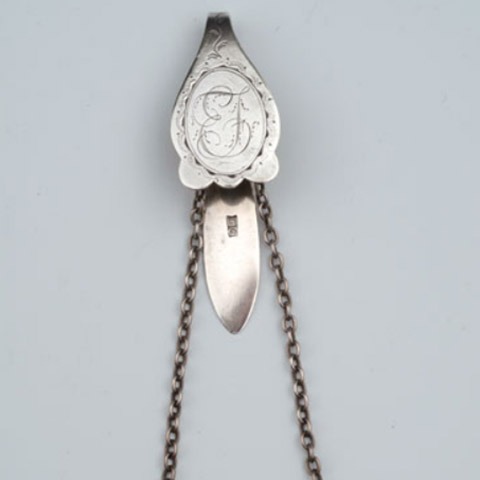

Women’s clothing of the 1700s and early 1800s was most often made without built-in pockets. Scissor hooks like this fit over the waistband of a skirt, and household necessities, such as keys and sewing tools, would hang from affixed chains. The maker of this hook, Eliakim Garretson, worked in the area of Wilmington, Delaware, and specialized in engraving decorations into metal objects.
SCISSOR HOOK (CHATELAINE)
ELIAKIM GARRETSON (CA. 1761–1827)
WILMINGTON, DELAWARE, CA. 1800–22
SILVER
PARTIAL GIFT OF COL. KENNETH P. AND REGINA I. BROWN; 2005.207
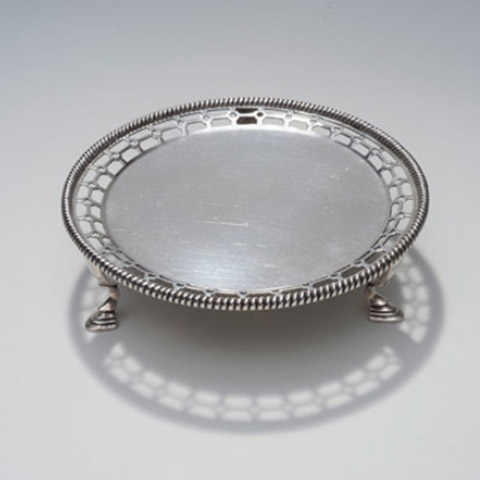

Known as one of Philadelphia’s finest silversmiths, Richard Humphreys began his career apprenticed under Bancroft Woodcock (1732–1817) in Wilmington, Delaware. He operated his own silversmith business in Wilmington for a short time before moving permanently to Philadelphia.
STAND OR WAITER
RICHARD HUMPHREYS (1749/50–1832)
PROBABLY PHILADELPHIA, CA. 1785–90
SILVER
GIFT OF SEWELL C. BIGGS; 1994.35


Before the United States gained its independence, Asian exports bound for America were funneled through England and sold to colonists for a profit. The Empress of China was the first American vessel to travel the long distance to China to obtain its precious goods. That vessel left New York in 1784 and returned with Asian luxuries—such as silk, tea, and porcelains—fourteen months later.
PUNCH BOWL
JINGDEZHEN, CHINA, CA. 1790
ENAMEL-DECORATED PORCELAIN
SEWELL C. BIGGS BEQUEST; 2004.130
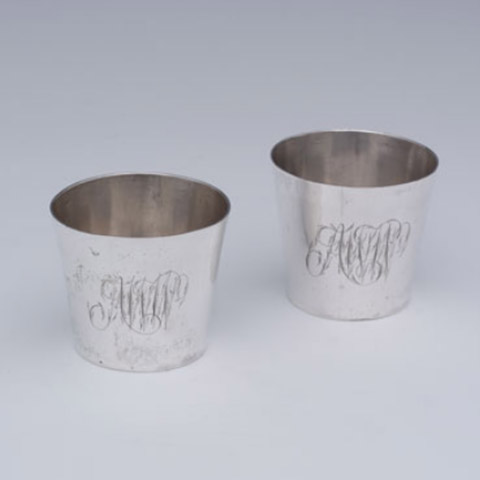

Camp cups were typically made to denote military service and were often carried by high ranking officials on their military campaigns. This particular pair, taken from a larger set of twelve, was made by Richard Humphreys, who was the most well-known American silversmith of his day. Humphreys made a set of camp cups for George Washington that was contemporaneous with this set, made for General Anthony Walton White. Family lore has it that one of the camp cups from this set of twelve was used by George Washington himself.
FOR FURTHER THINKING: Oral family traditions like the one associated with the larger set of these cups can often offer important insight into historic events. What are some of your family’s story? What might it convey to future generations about the past?
PAIR OF CAMP CUPS
RICHARD HUMPHREYS (1749/50-1832)
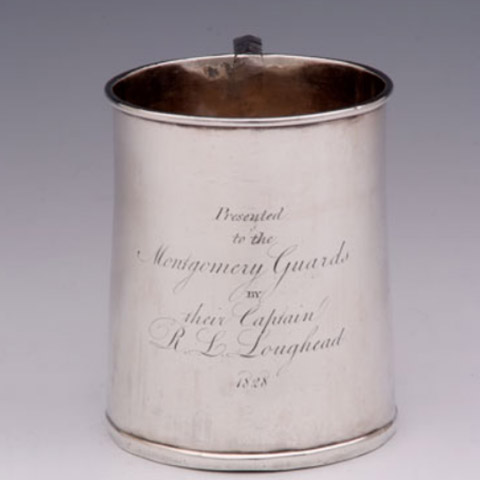

This mug was presented in 1828 to the Montgomery Guards, one of several Irish American paramilitary organizations in Philadelphia, by Robert L. Loughead, captain of the guards. Several of the Montgomery Guards would serve in the Civil War. They were eventually forced to disband because of anti-Irish and anti-Catholic sentiment.
FOR FURTHER THINKING: Immigrants and their descendants are crucial to the history of our country. Where did your ancestors come from? How might that have been important in our country’s history?


